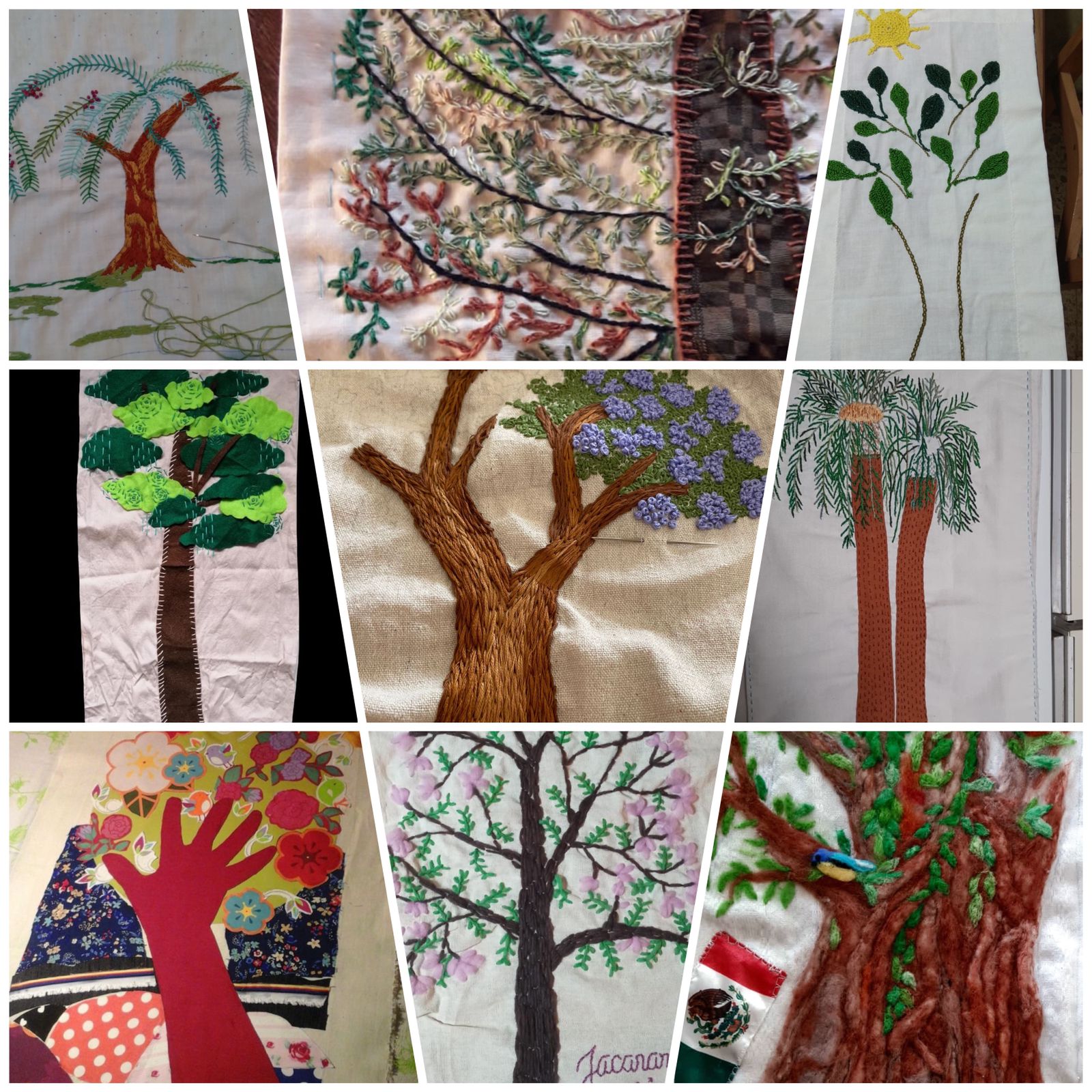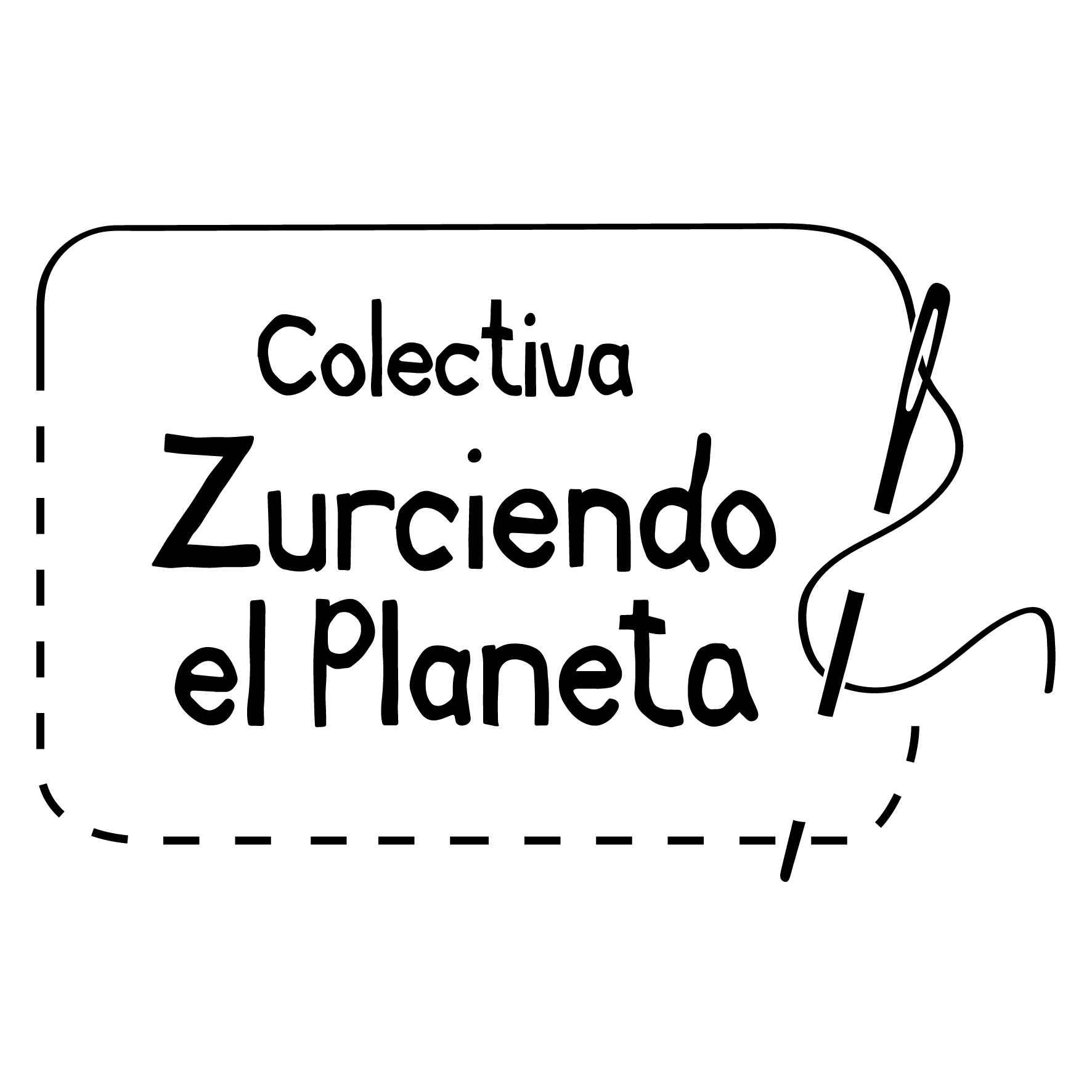Puedes ver este texto en el original (español) aquí
Inspired by the words of many stitchers and a text by Rob Hopkins

A city in Latin America, 2031
Hello!
You asked what life is like now. Let me tell you.
Temperatures rose to 1.5℃ compared to before the industrial era, in spite of our great efforts, but scientists report that in the last 2 years there have been no further increases and global green house gas emissions are going down every year.
We wake in the morning in our homes in a city in Latin America with too many millions of inhabitants. We live in neighbourhoods built mostly more than 50 years ago but mostly much better adapted to be less polluting and less resource hungry, especially in energy and water. There have been no new constructions in 10 years: there was a moratorium and all construction was halted, but we’ve also just been too busy, even the construction companies, improving the building stock we already have.
We open windows and the air smells clean, we can hear birds, lots of birds, and a few chickens. The gardens of each lot were very small but we knocked down lots of walls and opened doors between the little gardens to create a great common garden in the centre of our block. So now lots more people are daring to keep a few chickens to be a bit more self sufficient in eggs, and the chickens roam free and we all look after them.
In most of the neighbourhood, buildings have rainwater harvesting systems that were installed with municipal subsidies and the active participation of the neighbours. Most of the older buildings had to be altered in some way and most buildings increased the size of their cisterns to be able to store more water during the rainy season.
Almost all of us now have solar water heaters and also some solar panels. The panels are connected across the district and we have a small electricity coop with local families to share our electricity, as well as supporting local schools and community centres. If we have extra energy that isn’t consumed locally, we send it to the city grid.
Last year we also ran an initiative to install dry toilets. Half the families went for it (some people still struggle with the idea) and now we have a local project that comes every 2 weeks to pick up our full buckets. 4 young people have full time work running that, and they service 3 other neighbouring districts. They’re composting the drytoilet contents on an empty lot near here, one of the last undeveloped lots in the whole municipality. It was going to be built on 10 years ago, they already had the permits, but then there was no water for 2 months and at last people started to react, at first it got nasty… but in the end a moratorium of all building was declared and things started to change!
So now that last little bit of land is where they’re composting our dry toilets: no, it doesn’t smell or attract rats! It’s so cool! And after 12 months they have plenty of fertilizer for trees in public parks and on pavements. I used to think that the trees lining our streets looked ok, but since we started to actually feed them (and remove some of the concrete to give their roots some breathing space) they’ve grown so much and the fruit trees are actually flowering and fruiting, enoug for the birds and squirrels and some for us.
On the same piece of land there’s a recycling centre, although there’s less and less to recycle now because almost noone buys stuff that needs recycling and the manufacturing companies themselves almost don’t produce the stuff since they were obliged by law to take responsibility for the reprocessing of all their rubbish and it quickly turned out to be cheaper to stop producing those materials than to collect and recycle them!
Truth is, everything is working incredibly well, people are being really careful with water use, so the last couple of rainy seasons we’ve managed to store enough to see us almost through to the next rainy season. We only use «public water» for 2 or 3 months of the year. Which has also allowed the aquifers to be replenished a little. We also raised enough money to pull up the tarmac and pave our streets with a kind of porous concrete that allows the ground to absorb rainwater. In some blocks with very little traffic and where not many people had cars any more, the neighbours actually decided not to re-pave at all and turned the block into an urban garden. They planted lots of fruit and shade trees. We’re still working on that project, to make sure that streets and pavements across the whole district allow water infiltration.
So… we wake up in our nice houses, somewhat adjusted to this moment in the history of the Earth. We open curtains, windows, we can breathe fresh air, smell the wet soil and the neighbour’s coffee. The sky is blue and usually stays that way all day, except in the rainy season. I can’t remember now how long it’s been since the las emergency measures because of high levels of ozone or particulate matter, before the great pandemic, I think…
From the windows that look out onto the street, I can see trees lining the whole block, and raised community gardens along the pavements (on our block we weren’t able to turn the whole street into a garden). There’s a lot of pride for the different families and a kind of friendly rivalry over who has the tallest sunflower or the biggest pumpkin. But we also help each other out, exchange plants and the more knowledgable help the newbies.
There’s one thing that we don’t have any more: a year and a half ago the neighbours decided to pay a specialist to take down all the aerial cables that looked so ugly and had caused accidents and connection problems and which required trees to be cut in weird ways that were never good for the tree… and noone knew any more which of the hundreds of cables were actually still working or which belonged to whom. It was a huge undertaking and we spent a week without connectivity… but now we only have the cables we actually need and they’re all in casing along house fronts, accessible and labeled for repairs and out of the way at the same time.
Time for breakfast: local seasonal fruit from the community garden that’s taken over the area of the old public park, with bread from the sour dough bakery round the corner with homemade marmalade made with strawberries and raspberries from the community garden.
That garden is also the pride of the neighbourhood. We started out with a community compost and with that fertilizer they regenerated some of the sad soils in the park and planted more fruit trees and shrubs among the palms and big trees in the park. It’s even nicer and more peaceful to rest there now than it used to be and it actually contributes to our nutrition. There are several paid gardeners but lots of neighbours participate as volunteers to look after the plants and help with harvest. There’s always more people for harvest than for weeding and regular watering because that’s when there’s a big party and we eat together… but there’s never a shortage of volunteers because most people have discovered that spending a while outside in the green and with their hands in the mud actually makes them feel better!
It’s time to take the primary school children to school and go to work. Most of us work nearby now, and if it’s too far to walk, we go by bike. Most of us work 4 días a week and we’re home by 4pm so we can spend time with our families. This means we all live more peaceful existence but we’re also working better. And more of us have work too, because someone else covers for our 5th (and sometimes 6th) day of the week that we used to work. These arrangements also mean that we have more time to be with our community, with the children, helping out at the garden and helping a neighbour to fix something, or imagining more ways of regenerating the spaces that we live in.
When the children come home from school if midday and the sun is hot. But we walk the whole way home in the shade of trees, with several degrees lower temperature. We get home and they want to keep on playing with their friends. We take turns with other mums to bring the children home and cook and those collecting and cooking, chat while we prep and the children play without supervision in the street. There’s no homework and they don’t need anyone watching them.. They come in and out of their houses, the doors of the blocks of flats stand open — something unthinkable just 10 years ago. But we’re not afraid any more. We all know each other and so many people are in work that stealing is really rare. It doesn’t make much sense when more communities offer their surplus to anyone in need and find ways of giving them work. There are always neighbours on the street, tending to the gardens, drinking a coffee, having a chat, going for a walk.
We always had a few markets that set up in different parts of the district on different days of the week; these now only sell local produce. The whole system of food procurement has changed across the city. The big centralised wholesale market has collapsed, and certain nearby villages have established links with certain districts within the city. So local producers know exactly where their produce is going and consumers know where their food is coming from. Most producers have changed to agroecological methods though they’re still learning… There’s hardly any monoculture anymore, except for some export crops. At these local food markets we pay mostly in a local currency that you can only use in the city. The idea is that by using a local currency we keep the real value of things circulating in the city and close by.
Above all, the amazing thing about this moment we are living in, is that we keep on imagining how we could still live in even fairer and more regenerative ways. We’ve managed to show the doubters that this really is a good path. There are fewer and fewer who complain and object, but that only makes debates even more interesting because it’s not about old ideologies any more, now it’s everyone imagining freely and we keep thinking of more things! At first we had a hard time convincing some neighbours to make certain changes, but it’s getting easier and easier to come to agreements in community meetings. We’ve all learnt a lot about listening and imagining!
Hope you enjoyed your glimpse into the future!
See you soon,

